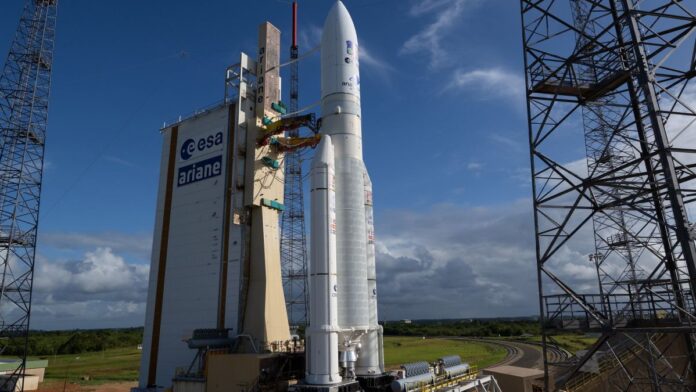Europe’s flagship mission to Jupiter looks ready to fly.
The European Space Agency (ESA) shared images of the Ariane 5 rocket that will send its JUICE spacecraft to Jupiter and its moons ahead of its April 13 launch. “#ESAJuice is on the move, getting closer to #DestinationJupiter,” the mission’s official Twitter account tweeted (opens in new tab) on Wednesday (April 12) alongside images of the rocket being rolled out the launch pad at Europe’s Spaceport in Kourou, French Guiana ahead of the planned liftoff.
The launch will mark the penultimate flight for the Ariane 5 rocket, which has been in service since 1996. After it takes off during a 1-second launch window, the rocket will send ESA’s JUICE spacecraft on an 8-year journey to Jupiter and three of its moons.
Related: JUICE: A complete guide to Jupiter’s icy moon exploring mission
After conducting a complex sequence of flybys of Earth, Earth’s moon and Venus in order to gain momentum from these bodies’ gravitational influence, JUICE will arrive at the Jovian system. Once there, the spacecraft will conduct an ambitious study to determine whether there are habitable environments on the moons Callisto, Ganymede or Europa, all of which are believed to have liquid-water oceans beneath thick shells of ice.
The Ariane 5 rocket that will launch the mission has had an impressive career and has earned a reputation for being reliable. Throughout its three decades of service, the Ariane 5 has launched five cargo missions to the International Space Station and in 2004 lofted what was at the time the heaviest telecommunications satellite to date. In December 2021, an Ariane 5 launched the revolutionary James Webb Space Telescope.
The final Ariane 5 flight is scheduled for June 21, 2023, during which it will carry two communications satellites to orbit on behalf of two private European customers.
The Ariane 5 will be phased out to make way for the Ariane 6, which is expected to make its first flight sometime late this year. The new rocket will feature an upper stage that can deliver satellites to various orbits and altitudes and will autonomously deorbit itself after delivering its payloads.
Follow Brett on Twitter at @bretttingley (opens in new tab). Follow us @Spacedotcom (opens in new tab), or on Facebook (opens in new tab) and Instagram (opens in new tab).


